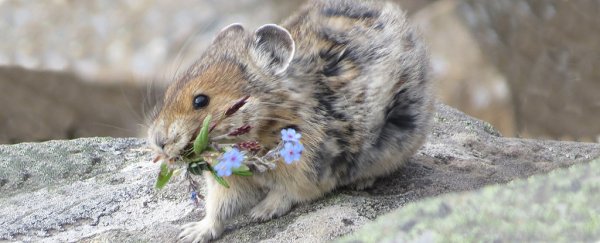The American pika (Ochotona princeps) is traditionally thought of as a canary in the coal mine when it comes to America's rising temperatures.
Making their homes high up in the cooler mountain regions of western North America, these adorable critters can overheat in high temperatures – making them incredibly sensitive to climate change.
Or at least that's what we thought.
A new literature review by conservationist Andrew T. Smith says otherwise – that the pika is doing remarkably well considering the circumstances.
"These results show that pikas are able to tolerate a broader set of habitat conditions than previously understood," Smith explains.
American pikas are small, territorial, rabbit-like creatures, that spend their days eating grasses and thistles, storing food for winter, squeaking at predators, and singing songs to potential mates.
They live in the mountains of Western North America – from British Columbia and Alberta in Canada all the way to New Mexico and California.
They make their homes in the mountains' talus fields – a landscape of broken stones and boulders, where they nest nest beneath rocks that keep them cool in hot conditions, and protect them from predators such as eagles, hawks and foxes.
To maintain their climate-controlled nests, scientists think they might slowly migrate further up the mountain to cooler conditions as the climate heats up year on year, but there's only so much mountain to climb before you reach a dead end.
They can't just move mountains when the temperature gets too hot – they're trapped on these sky islands.
Before we talk about the research itself, it's important to note that this study is a literature review – meaning that no new information has been found.
Instead, a literature review is a type of scientific paper that reviews current research and knowledge on a topic.
But placing individual studies into a broader context can reveal trends and inconsistencies that could otherwise be missed, and Smith believes that the American Pika is a lot better off than we thought.
"Much of the narrative regarding pikas and climate change has been based on studies from a restricted and marginal part of their geographic range," he writes in the paper.
"But because responses of pikas to their environment can vary greatly across their broad geographic range, care should be taken when generalizing from one region to another."
He points to a large range-wide survey back in 2018 done by his team where 3,250 records of occupied (or extant), recently empty (extirpated) or long empty (old-sign) pika sites across 40 mountain ranges were compiled and analysed.
"The large number of pika extant, extirpated, and old-sign, sites across the Great Basin documented by Millar et al., allowed a robust evaluation of how climatic features may have affected pika occupancy," he writes in the paper.
"While there were differences in climate values across six subregions of the Great Basin, for all extant sites the model expanded the range of both temperature and precipitation values compared with most other regions across the range of the species."
Smith did note that there are areas where American pikas aren't doing so well – low-elevations that are also isolated at the edges of their range. He thinks this is at least partially due to dispersal, or the spread of the species.
In small, isolated habitat patches there are less resources – including rock shelters – available for young pikas searching for their own nests, especially in the hotter low-elevation areas. The researchers have seen loss of local pika populations in these circumstances.
"Due to the relatively poor ability of pikas to disperse between areas, those habitats are not likely to be recolonised, particularly in light of our warming climate," Smith said in a press release.
"In spite of the general health of pikas across their range, these losses represent a one-way street, leading to a gradual loss of some pika populations."
However, Smith's review highlights the importance of understanding how a species is fairing across its entire range before drawing conclusions.
This obviously doesn't mean that climate change isn't a huge problem – especially for alpine species stuck on sky islands – and one we need to be tackling right now (or yesterday).
But it's nice to know that the tiny American pika might stand more of chance than we thought.
The paper has been published in the Journal of Mammalogy.
